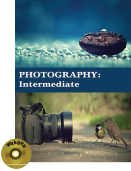Vocational

Photography: Intermediate comprehends various diverse practical and visual skills with knowledge of specialized materials and techniques. Photography is the science, art and practice of creating durable images by recording light or other electromagnetic radiation, either electronically by means of an image sensor, or chemically by means of a light-sensitive material such as photographic film. This book will introduce the knowledge and skills for those studying and/or working in photography industry to interpret and convey information in response to workplace requirements.
About this Book
The information in this book covers basic to core competencies that a person must achieve to take pictures of people, places, objects, and events and tries to artistically capture and evoke a mood, feeling, or drama surrounding a particular subject using a camera. The work of a photographer is not only limited to the actual use of the camera and proper lighting, but also includes all of the steps in the development of the image up to the presentation of the final product.
About the Photography Industry
Photographers take pictures of events, people and places. Many career options exist for photographers. Some common areas of specialization include news photography, commercial photography, scientific photography and fashion photography. A high school diploma is the minimum education needed to become a photographer, since technical skills and creativity are more important for employment than a degree. Photographers use cameras to capture an image. They can work in many different areas and often choose an area to specialize in. Photographers may work for a company, but many freelance. They find assignments by advertising or networking. Portrait photographers take pictures of people and events. They may work out of a studio that people visit. They also travel to events like weddings and meetings. Some portrait photographers specialize in school photos; they travel to schools to take pictures of students on picture day. News photographers, or photojournalists, work for magazines, newspapers, websites and television stations. They photograph current events and use images to convey information to the public. News photographers may work out of local news bureau but they often travel to the site of a breaking news story. Commercial and industrial photographers take pictures for books, magazines and advertisements. These pictures include buildings, archaeological findings, outdoor scenery and consumer goods. Commercial photographers may take pictures for advertising and marketing companies. Fine arts photographers sell the pictures they take as art. Their work may be featured in a museum or gallery. Fashion photographers photograph models in order to highlight a designer’s clothes. Scientific photographers may use specialized equipment to take pictures of cells, bacteria, internal body parts and faraway planets. They may need additional scientific training and may specialize in a specific type of scientific or medical photography. The salary range varies because location, reputation and area of specialization factors into a photographer’s fees. A freelance photographer’s annual salary depends on the number of assignments he or she receives and the fee he or she charges.